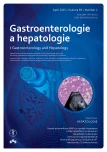Novel oral anticoagulants – the advantages and drawbacks of the therapy
Authors:
J. Bultas
Authors place of work:
Ústav farmakologie, 3. LF UK v Praze
Published in the journal:
Gastroent Hepatol 2015; 69(2): 152-160
Category:
Vybrané kapitoly z vnitřního lékařství: přehledová práce
doi:
https://doi.org/10.14735/amgh2015152
Summary
An advent of each new group of drugs associated with big expectations is inevitably followed by a period of critical evaluation. From the perspective of a gastroenterologist, a higher incidence of bleeding in the gastrointestinal tract associated with the use of some of the novel oral anticoagulants in comparison with warfarin is somewhat disappointing. Increased incidence of gastrointestinal haemorrhagic events was observed in both direct thrombin inhibitor – dabigatran, as well as some direct factor Xa inhibitors – xabans, specifically in rivaroxaban and edoxaban. In phase III clinical studies, the meta-analyses and analyses of registers has observed a relative increase in all bleeding events as well as major bleeding into the gastrointestinal tract of about a quarter to a half, but in absolute values the increase in the incidence is on average low, only 0.3%. However, for the individual drugs the absolute increase may be greater, e.g. in the case of rivaroxaban 1%. Given the fact that there are significant differences amongst individuals, rivaroxaban and dabigatran (at a dose of 2 × 150 mg) have a higher risk and the therapy with apixaban is not associated with a higher incidence of gastrointestinal bleeding, it is advisable for people at high risk of gastrointestinal bleeding to choose apixaban as the optimal anticoagulation therapy. The incidence of bleeding in the gastrointestinal tract is growing for a number of reasons, which increase the exposure to different drugs. These factors include in particular drug and food interactions, decreased renal functions, lower weight and some pharmacogenetic factors. Independently of the level of anticoagulants, the risk of gastrointestinal bleeding increases also the use of non-steroidal (even steroidal) anti-inflammatory drugs, infection with Helicobacter pylori or e.g. diverticulosis.
Key words:
gastrointestinal bleeding – dabigatran – rivaroxaban – apixaban – edoxaban
The author declares he has no potential conflicts of interest concerning drugs, products, or services used in the study.
The Editorial Board declares that the manuscript met the ICMJE „uniform requirements“ for biomedical papers.
Submitted:
24. 3. 2015
Accepted:
30. 3. 2015
Zdroje
1. Hijazi Z, Hohnloser SH, Oldgren J et al. Response to letter regarding article, „Efficacy and safety of dabigatran compared with warfarin in relation to baseline renal function in patients with atrial fibrillation: a RE ‑ LY (Randomized Evaluation of Long‑Term Anticoagulation Therapy) trial analysis“. Circulation 2014; 130(22): e195. doi: 10.1161/ CIRCULATIONAHA.114.012350.
2. Eikelboom JW, Wallentin L, Connolly SJ et al. Risk of bleeding with 2 doses of dabigatran compared with warfarin in older and younger patients with atrial fibrillation: an analysis of the randomized evaluation of long‑term anticoagulant therapy (RE ‑ LY) trial. Circulation 2011; 123(21): 2363 – 2372. doi: 10.1161/ CIRCULATIONAHA.110.004747.
3. Harper P, Young L, Merriman E. Bleeding risk with dabigatran in the frail elderly. N Engl J Med 2012; 366(9): 864 – 866. doi: 10.1056/ NEJMc1112874.
4. Hernandez I, Baik SH, Piñera A et al. Risk of bleeding with dabigatran in atrial fibrillation. JAMA Intern Med 2015; 175(1): 18 – 24. doi: 10.1001/ jamainternmed.2014.5398.
5. Loffredo L, Perri L, Violi F. Impact of new oral anticoagulants on gastrointestinal bleeding in atrial fibrillation: A meta‑analysis of interventional trials. Dig Liver Dis 2015. doi: 10.1016/ j.dld.2015.01.159.
6. Desai J, Kolb JM, Weitz J et al. Gastrointestinal bleeding with the new oral anticoagulants – defining the issues and the management strategies. Thromb Haemost 2013; 110(2): 205 – 212. doi: 10.1160/ TH13 ‑ 02 ‑ 0150.
7. Wallentin L, Yusuf S, Ezekowitz MD et al. Efficacy and safety of dabigatran compared with warfarin at different levels of international normalised ratio control for stroke prevention in atrial fibrillation: an analysis of the RE ‑ LY trial. Lancet 2010; 376(9745): 975 – 983. doi: 10.1016/ S0140 ‑ 6736(10)61194 ‑ 4.
8. Bytzer P, Connolly SJ, Yang S et al. Analysis of upper gastrointestinal adverse events among patients given dabigatran in the RE ‑ LY trial. Clin Gastroenterol Hepatol 2013; 11(3): 246 – 252. doi: 10.1016/ j.cgh.2012.10.021.
9. Paré G, Erikkson N, Lehr T et al. RE ‑ LY ‑ Genetics: genetic determinants of dabigatran plasma levels and their relation to clinical response. European Society of Cardiology 2012 Congress; August 29, 2012, Munich, Germany.
10. Schjerning Olsen AM, Gislason GH, McGettigan P et al. Association of NSAID use with risk of bleeding and cardiovascular events in patients receiving antithrombotic therapy after myocardial infarction. JAMA 2015; 313(8): 805 – 814. doi: 10.1001/ jama.2015.0809.
11. Sherid M, Sifuentes H, Sulaiman S et al. Risk of gastrointestinal bleeding with dabigatran: a head ‑ to ‑ head comparative study with rivaroxaban. Digestion 2014; 90(2): 137 – 146. doi: 10.1159/ 000365967.
12. Gouin‑Thibault I, Flaujac C, Delavenne Xet al. Assessment of apixaban plasma levels by laboratory tests: suitability of three anti‑Xa assays. A multicentre French GEHT study. Thromb Haemost 2014; 111(2): 240 – 248. doi: 10.1160/ TH13 ‑ 06 ‑ 0470.
Štítky
Dětská gastroenterologie Gastroenterologie a hepatologie Chirurgie všeobecnáČlánek vyšel v časopise
Gastroenterologie a hepatologie

2015 Číslo 2
- Metamizol jako analgetikum první volby: kdy, pro koho, jak a proč?
- Horní limit denní dávky vitaminu D: Jaké množství je ještě bezpečné?
- Souhrn klíčových vlastností a možností využití pegylovaného liposomálního irinotekanu v léčbě metastatického karcinomu pankreatu
- Perorální antivirotika jako vysoce efektivní nástroj prevence hospitalizací kvůli COVID-19 − otázky a odpovědi pro praxi
Nejčtenější v tomto čísle
- Maltofer®
- Atypický obraz infiltrace tračníku lymfomem u pacienta s chronickou lymfatickou leukemií
- Nová perorální antikoagulancia – přednosti a úskalí léčby
- Poruchy motility pažeráka – Chicagska klasifikácia, v3.0

